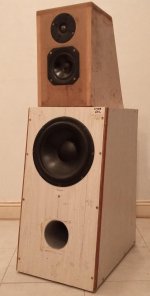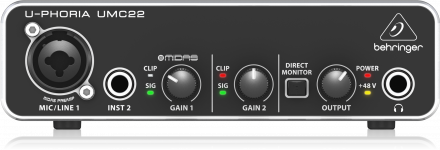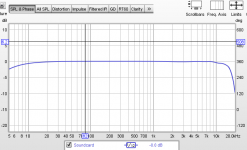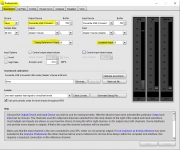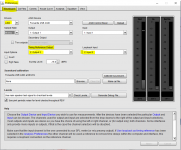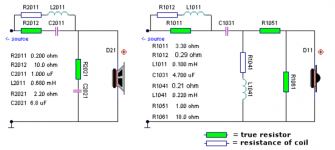Hi to all. I'm looking for help in designing a crossover network for a semi clone Tarkus built according to the design of The Tarkus by Paul Carmody. Why semi clone , simply because I am using Tweeter ScanSpeak Discovery tweeter D2608/9130, midrange from Monacor MS130 and Peerless woofer P830668 as used on the original design. All the drivers are fully burnt in. The enclosures are built on the original plan, but following a cut out error the bass bin is slightly bigger 64 L instead of 62. I am somewhat weak in xover design , but I am conversant with REW as regards measurements, I have a Uphoria UMC22 sound card and behringer ECM8000 microphone. My next post will provide the drivers' raw measurements following these questions:-
My 1st question : Is it ok to measure the drivers farfield at 1 meter or at listening position which is approx 2m50?
My 2nd question: Is it ok to measure all the drivers at tweeter height?
As for the woofer, I am not conversant with merging nearfield, farfield and port, although I have gone through ARTA explanations. personally I find it complicated in Arta to get a merged file. I have also tried to use Jeff Bagby xls which run really too slow and lags drastically on my computer. So any help from users will be appreciated. Enclosed photo of Semi clone Tarkus waiting for xover.
My 1st question : Is it ok to measure the drivers farfield at 1 meter or at listening position which is approx 2m50?
My 2nd question: Is it ok to measure all the drivers at tweeter height?
As for the woofer, I am not conversant with merging nearfield, farfield and port, although I have gone through ARTA explanations. personally I find it complicated in Arta to get a merged file. I have also tried to use Jeff Bagby xls which run really too slow and lags drastically on my computer. So any help from users will be appreciated. Enclosed photo of Semi clone Tarkus waiting for xover.
Attachments
Since you are using a 5" midrange, another option with the Peerless 830668 woofer-
Dennis Murphy's MBOW1
MurphyBlaster Productions
This uses a 5" GR Research M130 woofer vs 6.5" Peerless 830657
Dennis Murphy's MBOW1
MurphyBlaster Productions
This uses a 5" GR Research M130 woofer vs 6.5" Peerless 830657
Difficult project if done without prior experience. I see some problems here (listed in no particular order)
- getting the level correct between the bass and the mid
- the Fs of the mid is high, so it can be difficult to retain the original 400Hz crossover point, and that would mean to change also the bass crossover
- the mid box is wrong, as the chosen mid needs a much smaller volume
- AFAIK your mic is not calibrated, you risk to correct something that's not real
Regarding the questions, drivers measurement should be far field gated, set the mic at a fixed height (tweeter height is OK), and the distance mic-baffle is a compromise with the length of the gate. For mid-tweeter this usually is not a problem as you can go fairly close maintaining the far field approach (it depends on the driver and baffle dimensions), but can be a problem for the bass-mid section.
I see the Scan-Speak tweeter as an upgrade of the original Vifa one, I'm not sure I can say that for the mid.
Ralf
- getting the level correct between the bass and the mid
- the Fs of the mid is high, so it can be difficult to retain the original 400Hz crossover point, and that would mean to change also the bass crossover
- the mid box is wrong, as the chosen mid needs a much smaller volume
- AFAIK your mic is not calibrated, you risk to correct something that's not real
Regarding the questions, drivers measurement should be far field gated, set the mic at a fixed height (tweeter height is OK), and the distance mic-baffle is a compromise with the length of the gate. For mid-tweeter this usually is not a problem as you can go fairly close maintaining the far field approach (it depends on the driver and baffle dimensions), but can be a problem for the bass-mid section.
I see the Scan-Speak tweeter as an upgrade of the original Vifa one, I'm not sure I can say that for the mid.
Ralf
To echo what giralfino said: you are essentially contemplating a new 3 way design. 3 way designs are challenging.
I'll help.
Since you have a two channel soundcard, loop-back Chnl 2 into itself so that you get a zero reference ( in REW, you'll need to select this channel as the timing reference ).
- This will be critical ( for any crossover development ) so that the proper Z offsets are properly entered into the program ( XSim or VitixCAD2 ).
- Obviously, Chnl 1 will be for your test mic.
Q1; Measure all drivers ( individually ) at 1M on their Zero axis.
Q2; Measure all drivers ( individually ) at 1M on your preferred listening axis ( maybe that's the tweeter axis? ).
Q3; Merging the port response with the woofers individual response isn't that important to network design.
🙂
Since you have a two channel soundcard, loop-back Chnl 2 into itself so that you get a zero reference ( in REW, you'll need to select this channel as the timing reference ).
- This will be critical ( for any crossover development ) so that the proper Z offsets are properly entered into the program ( XSim or VitixCAD2 ).
- Obviously, Chnl 1 will be for your test mic.
Q1; Measure all drivers ( individually ) at 1M on their Zero axis.
Q2; Measure all drivers ( individually ) at 1M on your preferred listening axis ( maybe that's the tweeter axis? ).
Q3; Merging the port response with the woofers individual response isn't that important to network design.
🙂
Last edited:
If I understand correctly, you have the drivers in your possession.... Have you constructed a cabinet yet?
If you have a cabinet built, it is ideal to measure the drivers installed in their box. This way you capture the baffle step response.
If you do not yet have a cabinet, you can make an "infinite baffle" test board.
If you have a cabinet built, it is ideal to measure the drivers installed in their box. This way you capture the baffle step response.
If you do not yet have a cabinet, you can make an "infinite baffle" test board.
The 2 separate cabinets have been constructed and they appear on photo post#1 and the 3 drivers screwed thereon. The big baffle walls have been damped with polyester damping and woofer box tuned to 32 hz as measured in Limp. I only lack the essential xover. In the meantime I familiarising myself with xsim
You'll also need to provide impedance files ( .zma files ) created for each driver ( while each is housed in it's destination cabinet ).
REW ( or ARTA's associated program called LIMP ) can create these files for you.
You'll need to create a test jig first ( see; LIMP Tutorial pdf for some instruction.
🙂
REW ( or ARTA's associated program called LIMP ) can create these files for you.
You'll need to create a test jig first ( see; LIMP Tutorial pdf for some instruction.
🙂
here's 2 speakers that use the Monacor MS130
Frankenstein from Japan: Sansui SP-7700X - MV Audio Labs
Monacor Scout
https://www.teleprodottistore.it/files/Monacor.pdf
ScanSpeak tweeter D2608-9130
PEERLESS-NOMEX-164
Bookshelf-3WC
Frankenstein from Japan: Sansui SP-7700X - MV Audio Labs
Monacor Scout
https://www.teleprodottistore.it/files/Monacor.pdf
ScanSpeak tweeter D2608-9130
PEERLESS-NOMEX-164
Bookshelf-3WC
Last edited:
I had been unable to setup loopback from Input 2 (Inst2) to any of the output. I seem that only Input 1 (Mic/Line1) works for loopback.I'll help.
Since you have a two channel soundcard, loop-back Chnl 2 into itself so that you get a zero reference ( in REW, you'll need to select this channel as the timing reference ).
- This will be critical ( for any crossover development ) so that the proper Z offsets are properly entered into the program ( XSim or VitixCAD2 ).
- Obviously, Chnl 1 will be for your test mic.
Q1; Measure all drivers ( individually ) at 1M on their Zero axis.
Q2; Measure all drivers ( individually ) at 1M on your preferred listening axis ( maybe that's the tweeter axis? ).
Q3; Merging the port response with the woofers individual response isn't that important to network design.
🙂
One question:after calibration is done and cal file is saved, must I disconnect the loopback cable before proceed for measurements, as I must plug back my ECM mike into Input 1 (Mic/Line1) to proceed for measurements?
Attachments
Loop-Back is a physical connection made ( using an appropriate cable that's plugged in ) between Output 2 (R) and Input ( Input 2 ) Inst2 or "R" .
- The chnl loopback must remain in place when measurements are made.
- This chnl ( 2 ) provides a "zero reference" against which all other measurements are made
It'll all work properly once you master the basics in setting up REW's "Preferences" section.
- As mentioned earlier, you'll need to engage (ie; select ) a "Timing Reference Output" ( which is usually labelled R ( for right ouput ) when JAVA drivers are used .
- Outputs + Inputs are labelled differently when ( if ) ASIO drivers are chosen ( typically labelled numerically ).
See below;


I'm not going to turn my involvement here into a hand-holding session on navigating acoustic measurement software ( be it REW or ARTA ).
You don't seem to know your way around REW /// if that's true then I suggest you put your crossover design ambitions "On Pause" ( for the time being ) while you learn how to operate REW or ARTA .
- Once you've accomplished that ( basic REW competency ) return to this thread and we'll carry on.
EarlK
- The chnl loopback must remain in place when measurements are made.
- This chnl ( 2 ) provides a "zero reference" against which all other measurements are made
It'll all work properly once you master the basics in setting up REW's "Preferences" section.
- As mentioned earlier, you'll need to engage (ie; select ) a "Timing Reference Output" ( which is usually labelled R ( for right ouput ) when JAVA drivers are used .
- Outputs + Inputs are labelled differently when ( if ) ASIO drivers are chosen ( typically labelled numerically ).
See below;
I'm not going to turn my involvement here into a hand-holding session on navigating acoustic measurement software ( be it REW or ARTA ).
You don't seem to know your way around REW /// if that's true then I suggest you put your crossover design ambitions "On Pause" ( for the time being ) while you learn how to operate REW or ARTA .
- Once you've accomplished that ( basic REW competency ) return to this thread and we'll carry on.
EarlK
Attachments
After much struggling, I have at last found that there is an connection issue between input 2 and output 2, despite adjusting the volume control 2 fully and changing cables, there is still no response in Rew. Have installed also Asio, but in vain, no response, so I'll try another device. I have no other choice other than using my computer soundcard or my Soundcraft mixer, not the ideal solution, I know.
Thank you for your helpful explanations.
Thank you for your helpful explanations.
Hi fjadouce100,
As said before by giralfino
IMHO designing and voicing a three way from scratch is a really difficult job wich need a lot of time for measurements and simulation.
PS : Peerless 8109210 and D2608/9130 are the same product.
As said before by giralfino
My idea would be to replace the monacor mid by Peerless 830875 and reuse part of the filter of the Nomex 164. Low pass for 830875 and high pass for 810921.See attachment. You will have to add LPAD for the 83075 and adapt the value of the existing LPAD for the 810921. The first order low pass for the mid which is the 65 mF cap on the original crossover could be a starting point.Difficult project if done without prior experience. I see some problems here (listed in no particular order)
- getting the level correct between the bass and the mid
IMHO designing and voicing a three way from scratch is a really difficult job wich need a lot of time for measurements and simulation.
PS : Peerless 8109210 and D2608/9130 are the same product.
Attachments
Last edited:
1.Thanks Pguerin for your advice, but my goal is to learn the steps in designing a close to prefect crossover and secondly I did not want to undress the drivers on my latest diy nomex 164 which I have realized thanks to your advice. Good sounding speakers.
2. EarlK - Good news after reinstallation of windows 7, loopback works perfectly and I am trying some measurements. So FRDs nd ZMA will follow shortly. Do you need raw FRDs or gated ? and if so at what gate ms?
2. EarlK - Good news after reinstallation of windows 7, loopback works perfectly and I am trying some measurements. So FRDs nd ZMA will follow shortly. Do you need raw FRDs or gated ? and if so at what gate ms?
FR measurement should be gated (except for near field bass measure). The gate should be the longest you can achieve that contains all the impulse without any reflection. So it depends on the geometry (distance mic to baffle and distance mic to wall or floor).
Ralf
I still think that the chosen mid is a poor choice in the Tarkus upper box.
Ralf
I still think that the chosen mid is a poor choice in the Tarkus upper box.
Alain,
(i) Simply attach a "zipped" REW file here that includes the 3 separate on-axis captures ( iow > 3 traces captured with the test mic moving to on-axis for each driver ).
(ii) Attach a separate "zipped" REW file here that includes the 3 "listening axis" captures ( iow > 3 traces captured with the test mic staying in one location ).
(iii) Separate out to a separate REW file, the captured impedance traces ( obtained "in-box" ).
🙂
(i) Simply attach a "zipped" REW file here that includes the 3 separate on-axis captures ( iow > 3 traces captured with the test mic moving to on-axis for each driver ).
(ii) Attach a separate "zipped" REW file here that includes the 3 "listening axis" captures ( iow > 3 traces captured with the test mic staying in one location ).
(iii) Separate out to a separate REW file, the captured impedance traces ( obtained "in-box" ).
🙂
Cannot attach zip rew file: maxi size 3.81Mb
Each set zip file is approx 11Mb in size
Each set zip file is approx 11Mb in size
Last edited:
- Home
- Loudspeakers
- Multi-Way
- The Tarkus_Semi clone. Help in designing crossover.
